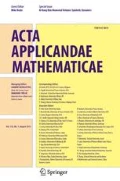Abstract
We give an introduction to the theory and to some applications of eigenvectors of tensors (in other words, invariant one-dimensional subspaces of homogeneous polynomial maps), including a review of some concepts that are useful for their discussion. The intent is to give practitioners an overview of fundamental notions, results and techniques.
Similar content being viewed by others
References
Börnsen, J.-P., van de Ven, A.E.M.: Tangent developable orbit space of an octupole. Preprint (2018). arXiv:1807.04817
Cartwright, D., Sturmfels, B.: The number of eigenvalues of a tensor. Linear Algebra Appl. 438, 942–952 (2013)
Chen, Y., Qi, L., Virga, E.G.: Octupolar tensors for liquid crystals. J. Phys. A 51(2), 025206 (2018)
Cox, D.A., Little, J., O’Shea, D.: Using Algebraic Geometry. Springer, New York (2004)
Decker, W., Lossen, Ch.: Computing in Algebraic Geometry. Algorithms and Computation in Mathematics, vol. 16. Springer, Berlin (2006)
Deimling, K.: Nonlinear Functional Analysis. Springer, Berlin (1985)
Dumortier, F., Llibre, J., Artes, J.: Qualitative Theory of Planar Differential Systems. Springer, Berlin (2006)
Gaeta, G., Virga, E.G.: Octupolar order in three dimensions. Eur. Phys. J. E 39, 113 (2016)
Gantmacher, F.R.: Applications of the Theory of Matrices. Dover, Mineola (2005)
Kaplan, J.L., Yorke, J.A.: Nonassociative, real algebras and quadratic differential equations. Nonlinear Anal. 3, 49–51 (1977)
Milnor, J.W.: Topology from the Differentiable Viewpoint. Princeton University Press, Princeton (1997)
Perko, L.: Differential Equations and Dynamical Systems. Springer, New York (1991)
Pumplün, S., Walcher, S.: On the zeros of polynomials over quaternions. Commun. Algebra 30, 4007–4018 (2002)
Oeding, L., Robeva, E., Sturmfels, B.: Decomposing tensors into frames. Adv. Appl. Math. 73, 125–153 (2016)
Qi, L.: Eigenvalues of a supersymmetric tensor. J. Symb. Comput. 40, 1302–1324 (2005)
Qi, L.: Eigenvalues and invariants of tensors. J. Math. Anal. Appl. 325, 1363–1377 (2007)
Qi, L.: Transposes, L-eigenvalues and invariants of third order tensors (2017). arXiv:1704.01327. Preprint
Qi, L., Chen, H., Chen, Y.: Tensor Eigenvalues and Their Applications. Springer, Singapore (2018)
Röhrl, H.: A theorem on nonassociative algebras and its application to differential equations. Manuscr. Math. 21, 181–187 (1977)
Röhrl, H.: On the zeros of polynomials over arbitrary finite dimensional algebras. Manuscr. Math. 25, 359–390 (1978)
Röhrl, H., Walcher, S.: Projections of polynomial vector fields and the Poincaré sphere. J. Differ. Equ. 139, 22–40 (1997)
Shafarevich, I.R.: Basic Algebraic Geometry. Springer, Berlin (1977)
Virga, E.G.: Octupolar order in two dimensions. Eur. Phys. J. E 38, 63 (2015)
Walcher, S.: Algebras and Differential Equations. Hadronic Press, Palm Harbor (1991)
Author information
Authors and Affiliations
Corresponding author
Appendix
Appendix
1.1 7.1 Some Linear Algebra
For the sake of completeness we prove the following commonly known fact: For real \(n\times n\) matrices \(A\) and \(B\) one has
First assume that \(A\) is invertible. Then
where \(I_{n}\) denotes the \(n\times n\) identity matrix and \(C=A^{-1}B\). The determinant of the first factor is equal to \((\det A)^{2}\), hence \(>0\); the second factor has determinant one, and for the third one we get
In the case of non-invertible \(A\) apply the argument to \(\rho I_{n}+A\) for small \(\rho >0\) and use continuity as \(\rho \to 0\).
To apply this to real representations of complex linear maps, let \(w=x+iy\in \mathbb{C}^{n}\) with \(x,\,y\in \mathbb{R}^{n}\), and write a linear map \(L\) from \(\mathbb{C}^{n}\) to \(\mathbb{C}^{n}\) in the form
hence \(L\) has a real matrix representation
1.2 7.2 A Hybrid Proof of Bezout’s Theorem
This proof uses Proposition 1 as an algebraic tool, and properties of the Brouwer degree on the analytic side. It is not central to the topic of the present paper but its inclusion is unproblematic and it may be seen as informative anyway.
By Proposition 1, in the complex affine space of structure coefficients, the coefficient sets which correspond to homogeneous polynomial maps \(Q\) with a nilpotent (\(v\neq0\) and \(Q(v)=0\)) form the hypersurface defined by the resultant. This hypersurface has real codimension two, hence any two points in its complement can be connected by a continuous curve. These points correspond to two homogeneous polynomial maps without nilpotents. By homotopy invariance they have the same Brouwer degree. To summarize, any two homogeneous polynomial maps of degree \(m\) without nilpotents have the same degree. For the special map
one easily verifies that the number of solutions of \(\widetilde{Q}(x)=(1, \ldots ,1)^{\operatorname{tr}}\) is equal to \(m^{n}\), with each solution having multiplicity one.
Rights and permissions
About this article
Cite this article
Walcher, S. Eigenvectors of Tensors—A Primer. Acta Appl Math 162, 165–183 (2019). https://doi.org/10.1007/s10440-018-0225-7
Received:
Accepted:
Published:
Issue Date:
DOI: https://doi.org/10.1007/s10440-018-0225-7


